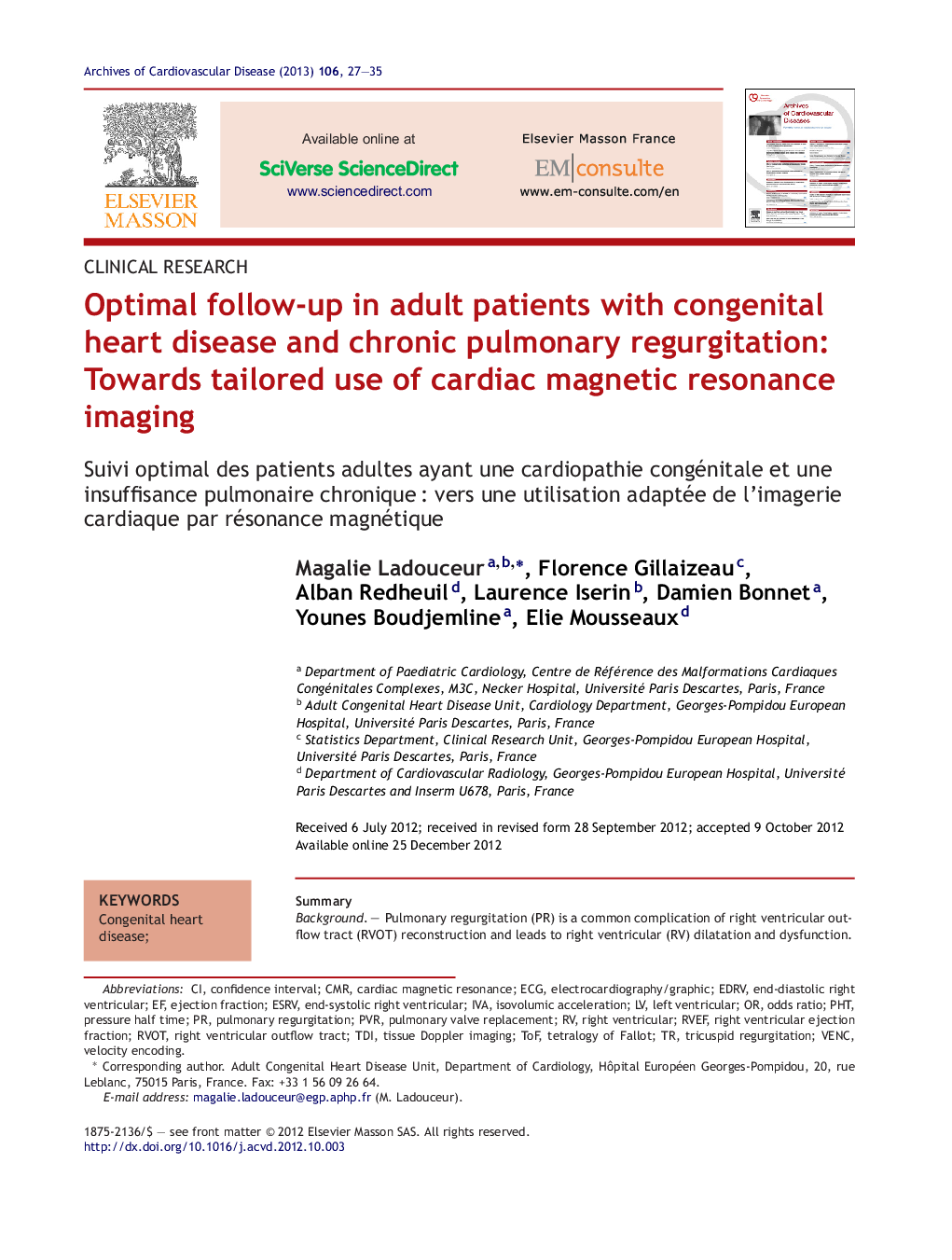| کد مقاله | کد نشریه | سال انتشار | مقاله انگلیسی | نسخه تمام متن |
|---|---|---|---|---|
| 2889404 | 1574368 | 2013 | 9 صفحه PDF | دانلود رایگان |

SummaryBackgroundPulmonary regurgitation (PR) is a common complication of right ventricular outflow tract (RVOT) reconstruction and leads to right ventricular (RV) dilatation and dysfunction. Although cardiac magnetic resonance (CMR) is the gold standard for evaluating PR and RV dysfunction, cost and limited availability are problems in many centres.AimsTo determine clinical, electrocardiographic and echocardiographic predictors of these complications and optimize patient selection for their short-term follow-up by CMR.MethodsNinety-four patients with a history of RVOT repair were prospectively included. All patients had a clinical examination, electrocardiography, echocardiography and CMR.ResultsQRS duration, indexed end-diastolic RV (EDRV) diameter and area on echocardiography were significantly associated with RV dilatation on CMR (P < 0.001). The distal localization of Doppler PR flow was the strongest echocardiographic criterion associated with severe PR (P < 0.001). Arrhythmia history and high Tei index were significantly associated with low RV ejection fraction (P < 0.001 and P = 0.017, respectively). In multivariable analysis, grade of PR, QRS duration, arrhythmia and valvulotomy were strongly associated with severe PR and RV dilatation or systolic RV dysfunction. From these results, an approach based on a scaled scoring system for selecting patients who need short-term CMR evaluation and close follow-up was evaluated. This method should avoid 31% of CMR examinations, with a sensitivity of 97.7%.ConclusionClinical, electrocardiographic and echocardiographic criteria can be used to accurately evaluate patients with RVOT repair. The combination of such features facilitates identification of patients who do or do not require close CMR evaluation.
RésuméContexteL’insuffisance pulmonaire (IP) est une complication fréquente de la reconstruction de la voie droite et entraîne une dilatation et une dysfonction du ventricule droit (VD). Bien que l’imagerie par résonance cardiaque soit la référence pour évaluer l’IP et la fonction VD, son coût et sa disponibilité limitée sont problématiques dans de nombreux centres.ObjectifsDéterminer les critères cliniques, ECG et échocardiographiques prédictifs de ces complications et optimiser la sélection des patients pour un suivi à court terme de ces complications par IRM.MéthodesQuatre-vingt-quatorze patients ayant des antécédents de reconstruction de la voie droite ont été inclus prospectivement. Tous les patients avaient un examen clinique, un ECG, une échocardiographie et une IRM.RésultatsLa durée du QRS, le diamètre et la surface télédiastoliques indexés du VD en échocardiographie étaient significativement associés à une dilatation VD en IRM (p < 0,001). La localisation distale de l’IP au Doppler était le critère le plus fortement corrélé à une IP sévère diagnostiquée en IRM (p < 0,001). Les antécédents d’arythmies et un indice de Tei augmenté étaient significativement associés à une dysfonction VD (p < 0,001 et p = 0,017, respectivement). En analyse multivariée, le grade de l’IP, la durée du QRS, l’arythmie et une valvulotomie étaient fortement associés à une IP sévère et une dilatation VD importante ou à une dysfonction systolique VD. À partir de ces résultats, une approche, basée sur un système de scores, pour sélectionner les patients qui ont besoin à court terme d’une évaluation IRM a été évaluée. Cette méthode permettrait d’éviter 31 % des examens IRM, avec une sensibilité de 97,7 %.ConclusionDes critères clinique, ECG et échocardiographiques peuvent être utilisés pour évaluer avec précision les patients ayant une chirurgie de la voie droite. La combinaison de ces caractéristiques permet de déterminer les patients qui nécessitent ou pas une évaluation rapprochée en IRM.
Journal: Archives of Cardiovascular Diseases - Volume 106, Issue 1, January 2013, Pages 27–35